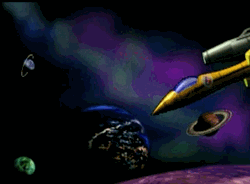 The Legend of Zelda: Breath of the Wild is an incredible game, and, should the Nintendo Switch crash and burn before we even get to see New Donk City, the Switch will be remembered fondly for its remarkable maiden voyage. Yes, there were other launch games, and, yes, Breath of the Wild is also available on the WiiU, but, for a healthy chunk of the gaming population, BoTW is always going to be the Switch, and you can’t buy that that kind of festering nostalgia. Like its ancestors, Super Mario Bros., Super Mario World, Super Mario 64, and Wii Sports, BoTW is a game that is going to define gaming for a console generation. BoTW makes one thing clear: We’re here, we’re top tier, and we wanna ride some bears. While there are many, many reasons this is the case, it all boils down to the fact that, from the first moment and until Ganon is in the grave, BoTW is just plain impressive. And, when you’re the ambassador for a whole new videogame system, “impressive” might be more important than anything.
The Legend of Zelda: Breath of the Wild is an incredible game, and, should the Nintendo Switch crash and burn before we even get to see New Donk City, the Switch will be remembered fondly for its remarkable maiden voyage. Yes, there were other launch games, and, yes, Breath of the Wild is also available on the WiiU, but, for a healthy chunk of the gaming population, BoTW is always going to be the Switch, and you can’t buy that that kind of festering nostalgia. Like its ancestors, Super Mario Bros., Super Mario World, Super Mario 64, and Wii Sports, BoTW is a game that is going to define gaming for a console generation. BoTW makes one thing clear: We’re here, we’re top tier, and we wanna ride some bears. While there are many, many reasons this is the case, it all boils down to the fact that, from the first moment and until Ganon is in the grave, BoTW is just plain impressive. And, when you’re the ambassador for a whole new videogame system, “impressive” might be more important than anything.
Trevor McFur in the Crescent Galaxy is the least impressive console launch game in history.
The Atari Jaguar might be the worst videogame system ever released (and, as the owner of a Virtual Boy, I don’t use that phrase lightly). For those of you that missed the heady age of the Sega vs. Nintendo days, back during the 16-bit era, Atari attempted to reassert its console dominance with the release of the Jaguar, the first 64-bit gaming system. Unfortunately, that “64-bit” headline legally required asterisk after asterisk, and, spoilers, the system was “64-bit” in the same way that a “Diet Slim Jim” is healthy eating. Aside from the fact that most of the Atari Jaguar library was simply a collection of (marginally) upscaled 16-bit ports, the Jaguar also possessed what may have been the worst controller in gaming history. Look at this abomination:
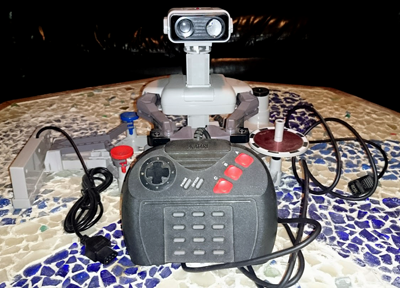
We’ve got three “action” buttons, a start/select, and a damned contemptible phone pad. What was the reasoning there? No one has ever enjoyed gaming on a phone pad (just ask anybody that tried those 1-900 “phone videogames” back in the 80s… not that I know anyone silly enough to try those things… on their parent’s credit cards… cough…), and it’s just few enough buttons to not work as a keyboard. I guess it could come in handy for a calculator-based videogame, but there is absolutely no part of that phrase that sounds fun at all. And heads up, holding that block of plastic is about as comfortable as attempting to beat Super Metroid with a particularly spiky rock. That is also on fire. And that fire burned off all your flesh and nerve endings long ago, so all you can do is sit and watch in horror as it consumes the last vestiges of your soul. And then your dog tells you she’s leaving you because you smell so horrible. Look, what I’m saying is that playing the Atari Jaguar is not in any way an enjoyable experience.
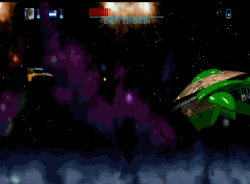 But there were people that bought the Atari Jaguar. Not many, mind you, as the system was a flop the likes of which the world hadn’t seen since the last time Atari tried to make videogame consoles, but there was definitely a user base (and, to be clear, I was not an Atari Jaguar early adopter, because
But there were people that bought the Atari Jaguar. Not many, mind you, as the system was a flop the likes of which the world hadn’t seen since the last time Atari tried to make videogame consoles, but there was definitely a user base (and, to be clear, I was not an Atari Jaguar early adopter, because Nintendo Power didn’t tell me to buy this system I have excellent taste). This means that, technically, there had to be people that purchased their brand new 64-bit videogame system, and, in a desperate need to see all this new system had to offer, purchased Trevor McFur in the Crescent Galaxy, the only non-pack-in game available at the launch of the Atari Jaguar. This isn’t the demo game! This is the real McFur! The first real game for the first 64-bit system in gaming history. This is going to be marvelous!
And… it’s a lame Gradius clone.
But a shoot ‘em up could have worked! If you look at the Dreamcast (from a far-flung future where Sega crashed and burned as badly as Atari), it seemed to do well with showing off “next gen” graphics on vertical and missile-based shoot ‘em ups. Sure, we’re still talking about “primitive graphics” compared to the likes of Soulcalibur and… Sonic Adventure? Huh. Yeah, maybe a shoot ‘em up is the best way to go. After all, it started the Super Nintendo off well with Gradius 3. Do you remember that stage that was totally on fire? That was rad.
But Trevor McFur doesn’t even muster the raw graphical impressiveness of its 16-bit brethren. What we have here is a “space shooter” with levels that appear to be endless slogs in front of the most generic backgrounds available. There’s something distinctly… 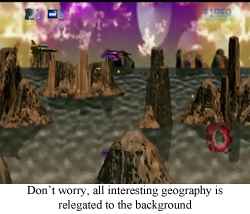 low rent going on here, as if someone made one passable tile, and then copy and pasted it ad nauseam. All of the worlds start in space, which is penny-saver black, and then you’ve got the planets themselves, which are “generic sci-fi fantasy”, save the one level that is inexplicably just a child’s drawings. I guess it’s supposed to be a virtual world or something? Don’t know, don’t care. What I do know is that these stages all feature approximately three different enemies, and they’re repeated about as generously as their tiresome backgrounds. All told, it makes every level seem about five times longer than it really is, because you’ve literally seen everything a stage has to offer within its first few seconds. Except the bosses, which, legitimately, appear to be where the “64-bit graphics” of Trevor McFur went… except they have way too much life and the dumbest patterns, so even those showcase pieces crumble too dust (albeit, not nearly fast enough).
low rent going on here, as if someone made one passable tile, and then copy and pasted it ad nauseam. All of the worlds start in space, which is penny-saver black, and then you’ve got the planets themselves, which are “generic sci-fi fantasy”, save the one level that is inexplicably just a child’s drawings. I guess it’s supposed to be a virtual world or something? Don’t know, don’t care. What I do know is that these stages all feature approximately three different enemies, and they’re repeated about as generously as their tiresome backgrounds. All told, it makes every level seem about five times longer than it really is, because you’ve literally seen everything a stage has to offer within its first few seconds. Except the bosses, which, legitimately, appear to be where the “64-bit graphics” of Trevor McFur went… except they have way too much life and the dumbest patterns, so even those showcase pieces crumble too dust (albeit, not nearly fast enough).
In short, there is nothing about Trevor McFur that encourages you to play the game.
And it’s funny how that complete blunder can sour you on an entire system. The Atari Jaguar has an awful controller, and its smattering of software was terrible. Trevor McFur was just the leader of the first vanguard, it’s not like (the other launch game) Cybermorph, Kasumi Ninja, Zool 2, or (ugh) Atari Karts ever did anything to rectify the situation. There was never any fun to be had on the Atari Jaguar, so it’s no surprise it crashed into the annals of Horrible Videogame History. And, yes, it all started with Trevor McFur, the least impressive launch game ever.
Or maybe I’m wrong. Maybe Trevor McFur was never a videogame. Perhaps Trevor McFur in the Crescent Galaxy was nothing more than a warning to others in cartridge form. I suppose it’s a warning a number of people heeded.
FGC #266 Trevor McFur in the Crescent Galaxy
- System: Atari Jaguar. Just the Atari Jaguar.
- Number of players: This kind of suffering can only be experienced by one person at a time.
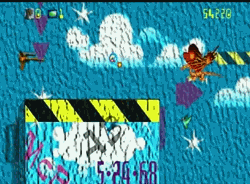 Favorite Powerup: Oh yeah, unless I’m missing a button here, there are a myriad of powerups available, but you have no control over which powerup is used at any given time. Maybe I’m supposed to touch that damn keypad? I’m not doing that. Regardless, one of the powerups summons a little ship dude to help out, and that’s a damn bit more useful than the magnet attack that drags monsters right into Trevor’s windshield.
Favorite Powerup: Oh yeah, unless I’m missing a button here, there are a myriad of powerups available, but you have no control over which powerup is used at any given time. Maybe I’m supposed to touch that damn keypad? I’m not doing that. Regardless, one of the powerups summons a little ship dude to help out, and that’s a damn bit more useful than the magnet attack that drags monsters right into Trevor’s windshield.- Say something nice: I do like that there’s a full paragraph of “lore” for every planet and monster. They’re not really well thought out (there seems to be no distinguishing between a “planet” and a “moon”), but at least somebody tried the tiniest bit.
- I just got that: Trevor McFur is a jaguar. Right. Duh.
- Did you know? Trevor McFur in the Crescent Galaxy was released the last day of November, 1993. Star Fox, a furry-based shoot ‘em up designed to showcase new videogame hardware, was released in North America on March 26, 1993.
- Would I play again: Does anybody want a used Atari Jaguar?
What’s next? Random ROB has chosen… Home Alone for the NES! Wow, ROB, really great picks here, champ. What’s next? Spice World 2? Bah, please look forward to even more fun!
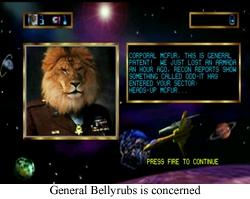
“There was never any fun to be had on the Atari Jaguar”
It was the original/debut platform for Rayman, though Ubisoft switched to focus on the PlayStation during development and put it out on that system like eight days later with more content and better audio quality. And that was before the game was ported to Saturn, PC, three generations of Nintendo handhelds, and mobile phones.
Yeah, like its brothers in bad design the Panasonic 3DO and Philips CD-i, the Atari Jaguar was one of those me-too 90s systems. At least the 3DO had a useable controller and Japanese games, and the CD-i had three mediocre Zelda games (and one Mario one) with hi-lariously bad cutscenes as a “Nintendo wants out of this CD add-on deal bad” compromise. What’s Jaguar got? An exclusive Bubsy sequel. =/
On the game: I think it’s weird for the only launch game to be a shooter. Gradius III worked not just ‘cuz it’s a better shooter, but because it wasn’t the only title at the SNES’s US launch; Super Mario World came with the system as an awesome pack-in and you also had choices between Mode 7 racing (F-Zero), a Mode 7 tech demo-y flight training simulation (Pilotwings), and a city sim (SimCity).
Speaking of shooters, they’re one of those genres (see also sports, puzzles, random arcade ports) that appear to show up en masse on a system once it’s dying or dead. Maybe it’s ‘cuz they’re a lot cheaper and easier to make than other genres, especially the bullet hell kind.
And I see General Patent is literally just a photo of a general with a lion’s head pasted on. How adorably lazy.
[…] of a Donkey Kong follow-up for the Super Famicom CD, the Atari “mystery machine” codenamed Jaguar, and “a new spin on the Sonic saga called Sister Sonic… apparently an RPG starring Sonic’s […]
[…] around, bro. It was on the computer. It was on the Super Nintendo. It was on the 32X. It was on the Jaguar. It was on the Playstation, Saturn, and 3DO. It eventually wound up on the Gameboy Advance. It was […]
[…] biggest difference between its original form and its eventual N64 version? It was intended to be an Atari Jaguar game, and was featured as such in the Winter of 1995. Now, everyone alive knows the sad tale of the […]